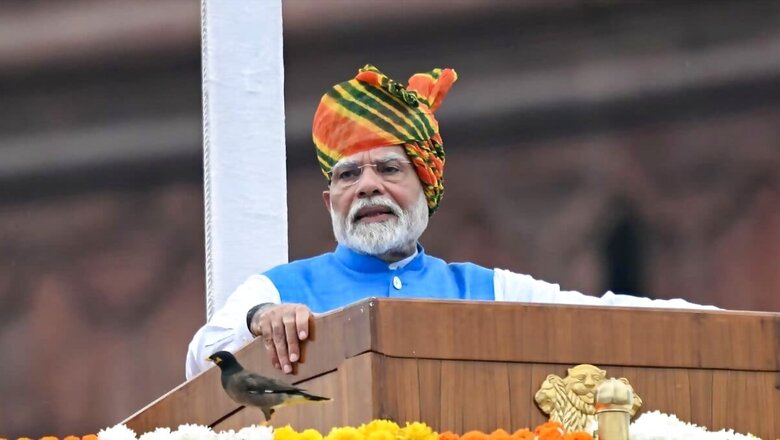
views
As a young professional armed with a degree from a prestigious institution, my passion for contributing to society and national development has always driven me. My journey across India’s diverse landscape in the higher education sector has allowed me to engage with students from all walks of life. These interactions have provided me with a unique perspective on the transformative changes taking place, even in the most remote parts of our country. The stories and aspirations of the youth I encountered have led me to delve deeper into the phenomenon that is reshaping India — Prime Minister Narendra Modi.
Prime Minister Modi’s unwavering commitment to making India’s youth the driving force behind a Viksit Bharat (Developed India) has been evident throughout his tenure. This vision was powerfully articulated during his 78th Independence Day speech, where he called upon all 140 crore citizens, especially the youth, to actively participate in the Viksit Bharat agenda. Inspired by this vision, I eagerly joined his campaign to spread this message across the country.
Over the past decade, Modi’s government has implemented a series of innovative measures aimed at empowering the youth. These initiatives have provided platforms for the youth to ‘perform,’ ‘reform,’ and ultimately ‘transform’ their lives. A closer analysis reveals that the true brilliance of Modi’s leadership lies not only in the announcement of ground-breaking schemes and policies but in the holistic approach adopted to ensure their success.
A Balanced Strategy for Empowerment
Upon examining the various youth-centric policies, I decoded a robust and visionary strategy designed to create both demand and quality supply within the country.
1. Inclusive Policies: The mantra of ‘Sabka Saath, Sabka Vikas’ has evolved into a movement that ensures the welfare of all through inclusive policy measures. This approach is reflected in government initiatives that cater to different demographics across the nation, empowering not just a segment of the youth but all of them.
2. Strengthening Tertiary Education: The National Education Policy (NEP) is set to revolutionise India’s education system, particularly the tertiary sector. By creating professionals with a liberal education model, equipped with the right mix of knowledge, skills, and national pride, the NEP aims to nurture future leaders. This is further supported by the establishment of more public institutions and increased access to education loans, making quality education accessible to all.
3. Skilling, The Pillar of Viksit Bharat: Skilling has been identified as a critical step towards realising Viksit Bharat. The Pradhan Mantri Kaushal Vikas Yojana (PMKVY), launched in 2015, has skilled over 10 million youth, significantly boosting vocational education in India. With the aim of skilling 20 lakh more youth in the next five years, and aligning the Skill India mission with Industry 4.0, India is on track to become the ‘Global Skill Capital.’
4. Specialised Schemes for Unique Segments: Special schemes like the Deen Dayal Upadhyaya Grameen Kaushalya Yojana, launched in 2014 to skill rural youth, and the PM Vishwakarma Yojana, aimed at skilling youth from Vishwakarma families, demonstrate the government’s customised approach to catering to the unique needs of different groups.
5. Improving Employability: The National Apprenticeship Promotion Scheme (NAPS), introduced in 2016, along with the New Internship Policy proposed in this Union Budget, are effective mechanisms for bridging the gap between university education and the professional world. These initiatives enhance the employability of students and further support workforce skilling.
6. Creating Job Creators: The strategy distinguishes itself by focusing on creating not just job seekers but job creators. Initiatives like Start-Up India and Stand-Up India, combined with improvements in ease of doing business, have ignited the entrepreneurial spirit among India’s youth, giving wings to their aspirations.
7. Opportunities for All: While India’s Gross Enrolment Ratio has risen from 23.7 in 2014-15 to 28.4 in 2021-22, there is still work to be done. The ‘Agnipath’ scheme, which allows young people to serve the nation in the armed forces on a short-term basis, provides a gateway to numerous productive opportunities for those who may not be part of the formal higher education system.
8. Opportunities in Sunrise Sectors: The government has also opened up opportunities in sunrise sectors, the space industry, the semiconductor sector, and other emerging fields. This focus on unconventional options allows India’s youth to tap into new opportunities, strengthening the economy.
9. Enabling Youth in Governance: With the induction of 1,00,000 youth without any political family background across all levels of administration, India is poised to witness fresh blood in governance and politics. This will open up opportunities for the youth in public life.
Conclusion
By connecting these dots one can see the strategy manifest itself as an effective supply chain of Human Resources for Viksit Bharat. This strategy unravels the tacit execution plan for propelling India to become the largest global economy and to emerge as the ‘Vishwaguru.’
India’s youth, equipped with knowledge, skills, and a strong sense of national pride, are now the torchbearers of change. As they continue to build, innovate, and lead, the dream of a developed India is no longer just a distant vision; it is becoming a reality. This transformation was, powerfully symbolised by the 600 NCC and NSS student volunteers who stood in the formation of ‘MY Bharat’ at the Red Fort during the Independence Day celebrations. The Viksit Bharat of 2047 is truly Mera Yuva’s Bharat.
(The writer is a lawyer and trustee of Vijaybhoomi University and IFIM Institutions. Views expressed in the above piece are personal and solely that of the author. They do not necessarily reflect News18’s views.)














Comments
0 comment